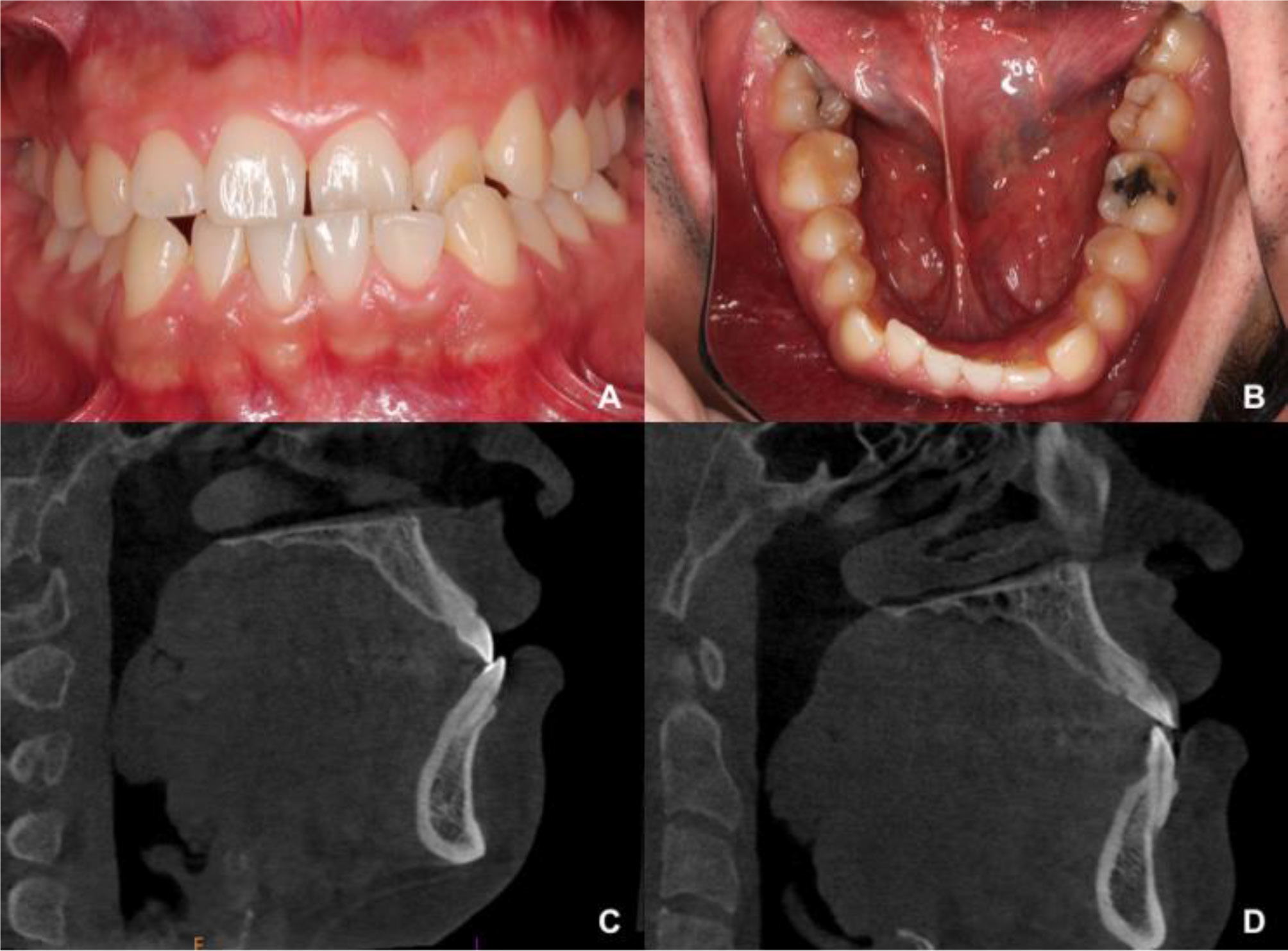Resumo
As contenções fixas em ortodontia têm demonstrado excelentes resultados para a estabilidade e durabilidade do tratamento. Apesar disso, observou-se que existem certos movimentos dentários indesejados totalmente diferentes de uma recorrência à sua posição inicial anterior ao tratamento ortodôntico. O chamado “efeito de torção” é um deles, e se caracteriza por uma inclinação em sentidos opostos dos caninos contralaterais, onde um apresenta uma inclinação para vestibular e outro para lingual ou palatino. Ocorre principalmente na mandíbula, apesar do retentor permanecer perfeitamente preso aos dentes. O objetivo desta revisão bibliográfica é avaliar os diferentes fatores relatados na literatura que podem estar relacionados ao aparecimento do “efeito turn” e quão relevantes podem ser no seu desenvolvimento. Em conclusão, é importante considerar a natureza multifatorial deste tipo de complicações, onde o tipo e a qualidade do fio utilizado para contenção, juntamente com as características periodontais do paciente, mostraram algum envolvimento na sua génese, pelo que é essencial conscientizar os pacientes sobre a importância de check-ups ortodônticos periódicos após a remoção dos aparelhos fixos para monitorar e controlar os resultados oclusais alcançados e o estado dos dispositivos de contenção instalados
Referências
Kučera J, Marek I. Unexpected complications associated with mandibular fixed retainers: A retrospective study. Am J Orthod Dentofacial Orthop. 2016;149(2):202–11.
Pancherz H, Bondemark L. The bite-type malocclusion classification – An extended Angle-method. Is the new classification reliable? APOS trends orthod . 2021;11(100):100–5.
Shaughnessy TG, Proffit WR, Samara SA. Inadvertent tooth movement with fixed lingual retainers. Am J Orthod Dentofacial Orthop. 2016;149(2):277–86.
Nanda RS, Nanda SK. Considerations of dentofacial growth in long-term retention and stability: is active retention needed? Am J Orthod Dentofacial Orthop . 1992;101(4):297–302.
Lai CS, Grossen JM, Renkema A-M, Bronkhorst E, Fudalej PS, Katsaros C. Orthodontic retention procedures in Switzerland. Swiss Dent J. 2014;124(6):655–61
Katsaros C, Livas C, Renkema A-M. Unexpected complications of bonded mandibular lingual retainers. Am J Orthod Dentofacial Orthop . 2007;132(6):838–41.
Renkema A-M, Renkema A, Bronkhorst E, Katsaros C. Long-term effectiveness of canine-to-canine bonded flexible spiral wire lingual retainers. Am J Orthod Dentofacial Orthop. 2011;139(5):614–21.
Roussarie F, Douady G. A side-effect of bonded retention wires: the “wire syndrome”: part 1. J dentofac anom orthod. 2016;19(1):106.
Pazera P, Fudalej P, Katsaros C. Complication sévère d’une contention collée linguale mandibulaire. Orthod Fr. 2014;85(2):217–22.
Kapila S, Sachdeva R. Mechanical properties and clinical applications of orthodontic wires. Am J Orthod Dentofacial Orthop. 1989;96(2):100–9.
Sifakakis I, Pandis N, Eliades T, Makou M, Katsaros C, Bourauel C. In-vitro assessment of the forces generated by lingual fixed retainers. Am J Orthod Dentofacial Orthop. 2011;139(1):44–8.
Horowitz SL, Hixon EH. Physiologic recovery following orthodontic treatment. Am J Orthod. 1969;55(1):1–4.
Johnston CD, Littlewood SJ. Retention in orthodontics. Br Dent J . 2015;218(3):119–22.
Little RM, Riedel RA, Artun J. An evaluation of changes in mandibular anterior alignment from 10 to 20 years postretention. Am J Orthod Dentofacial Orthop. 1988;93(5):423–8.
Little RM. Stability and relapse of dental arch alignment. Br J Orthod. 1990;17(3):235–41.
Richardson ME. Late lower arch crowding facial growth or forward drift? Eur J Orthod. 1979;1(4):219–25.
Sadowsky C, Schneider BJ, BeGole EA, Tahir E. Long-term stability after orthodontic treatment: nonextraction with prolonged retention. Am J Orthod Dentofacial Orthop. 1994;106(3):243–9.
Kocher KE, Gebistorf MC, Pandis N, Fudalej PS, Katsaros C. Survival of maxillary and mandibular bonded retainers 10 to 15 years after orthodontic treatment: a retrospective observational study. Prog Orthod. 2019;20(1):28.
Mills JR. The stability of the lower labial segment. A cephalometric survey. Dent Pract Dent Rec. 1968.
Pizarro K, Jones ML. Crown inclination relapse with multiflex retainers. J Clin Orthod. 1992
Sifakakis I, Eliades T, Bourauel C. Residual stress analysis of fixed retainer wires after in vitro loading: can mastication-induced stresses produce an unfavorable effect? Biomed Tech (Berl). 2015;60(6):617–22.
Dahl EH, Zachrisson BU. Long-term experience with direct-bonded lingual retainers. J Clin Orthod. 1991;25(10):619–30.
Arnold DT, Dalstra M, Verna C. Torque resistance of different stainless-steel wires commonly used for fixed retainers in orthodontics. J Orthod. 2016;43(2):121–9.
Pandis N, Vlahopoulos K, Madianos P, Eliades T. Long-term periodontal status of patients with mandibular lingual fixed retention. Eur J Orthod. 2007;29(5):471–6.
Levin L, Samorodnitzky-Naveh GR, Machtei EE. The association of orthodontic treatment and fixed retainers with gingival health. J Periodontol. 2008;79(11):2087–92.
Richardson ME, Gormley JS. Lower arch crowding in the third decade. Eur J Orthod. 1998;20(5):597–607.
Al-Moghrabi D, Pandis N, Fleming PS. The effects of fixed and removable orthodontic retainers: a systematic review. Prog Orthod 2016;17(1):24.


